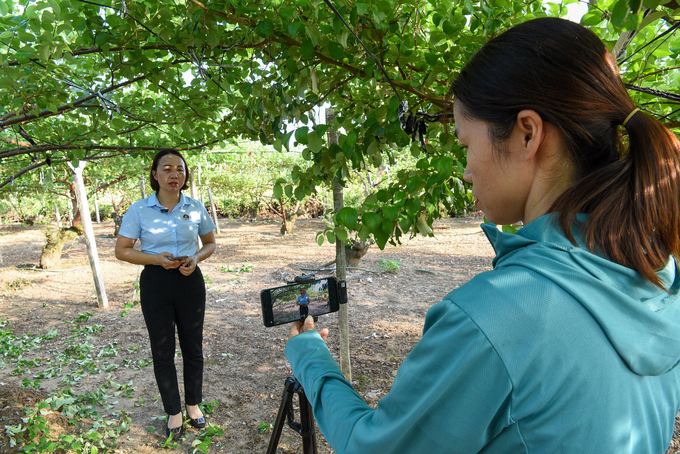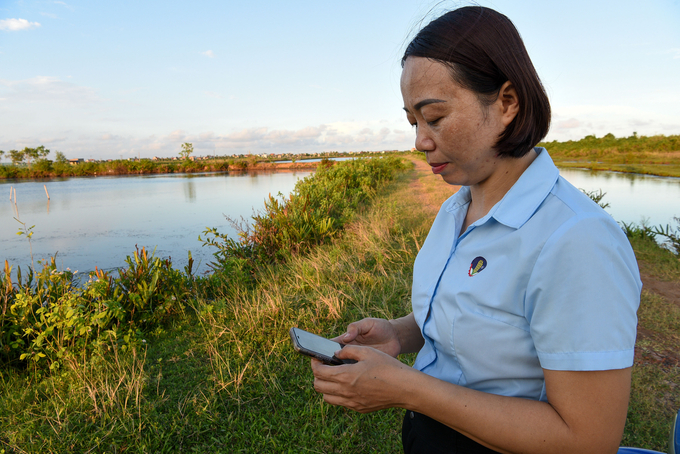December 31, 2025 | 02:13 GMT +7
December 31, 2025 | 02:13 GMT +7
Hotline: 0913.378.918
December 31, 2025 | 02:13 GMT +7
Hotline: 0913.378.918

Mrs. Duoc is hosting a promotional agriculture clip. Photo: Duong Dinh Tuong.
Mrs. Dang Thi Duoc, an officer at the Agricultural Extension Station in Tien Lang District, shared that after attending a one-week course on producing promotional agriculture clips at the Hai Phong Agricultural Extension Center, her team is required to produce a sufficient quantity and quality of video clips each week as per the regulations. As the person responsible for writing the scripts for the 4 to 5-minute clips, she commented that it is similar to writing an essay, which includes an introduction, body, and conclusion. The introduction features a greeting and an overview of the content; the body discusses the cultivation techniques of exemplary models, and if the duration is longer, it can also include information about the products of these models and the demand for their market connections. The conclusion consists of a farewell.
Each week, the Agricultural Extension Station in Tien Lang District, along with other stations under the Haiphong Agricultural Extension Center, is required to produce five video clips. “When it comes to writing the sixth or seventh script, I often find myself at a loss for ideas because they all seem to follow the same pattern, focusing on pest control using a similar template. The agricultural extension officers from various stations throughout the city have created a Zalo group where, every Friday night from 8 PM to around 11 PM, we hold Zoom meetings to report on our activities for the week. We expressed our concerns about the difficulties in writing scripts, which led the Haiphong Agricultural Extension Center to decide to use ChatGPT to assist in scriptwriting for added creativity”, Mrs. Duoc said.
At each agricultural promotion station, one staff member has ChatGPT installed on their phone and has access to an account. This means that instead of spending several hours crafting a script as we used to, it now only takes a few minutes for the AI to generate the content, after which we simply refine it to complete the final version. This approach to scriptwriting allows us to work from anywhere and at any time, significantly improving our efficiency and creativity in producing these educational clips.

Mrs. Duoc reviews the script written by ChatGPT right by the pond. Photo: Duong Dinh Tuong.
Mrs. Duoc then pulled out her phone and crafted a request for ChatGPT: “Households growing Taiwan large apples organically with high efficiency”. Within a few seconds, the artificial intelligence responded with a detailed description of the techniques for cultivating and caring for Taiwan large apples. However, she found the information didn't quite fit her needs, so she decided to revise her request: “Households successfully achieving high income through organic Taiwan large apple varieties in Vinh Quang Commune, Tien Lang District". This time, the AI quickly generated a response, beginning with an introduction about the techniques for cultivating organic Taiwan large apples. The body of the response elaborated on the economic efficiency and sustainable benefits of this farming approach, followed by a concluding section. The complete output totaled around 500 words.
Not yet satisfied, Mrs. Duoc issued another command: “Make it double the length”. As a result, ChatGPT generated a document approximately 1.000 words long, offering more detailed content that was better suited for a clip script. She revised this version and then copied the script into Zalo to share with the video production group for that afternoon. They were scheduled to head to the apple orchard of Mrs. Vu Thi Rua in Tan Quang Village, Vinh Quang Commune, to carry out their work. Like a full-fledged television production team, the five officers from the station each took on specific roles: one handled the script, another was in charge of filming, while others focused on post-production, uploading the video to YouTube, and responding to comments.
Mrs. Nguyen Thanh Tung, who is in charge of filming, explained that after reviewing the script, she needed to be creative by imagining how to capture the scenes if she were standing in the rice field, by the pond, or in the livestock barn. She had to think about what types of shots to use wide shots, medium shots, and close-ups while also considering how to film the host in a way that felt natural and relatable.
In addition, the agricultural extension officers responsible for the commune, after receiving training on video production, became more aware of their surroundings. Whenever they spotted something relevant on the road or at the site, they would quickly pull out their phones to record or conduct interviews to send back to the production team for processing, creating valuable documentation for their clips.
Translated by Phuong Linh

(VAN) From extensive shrimp ponds, baskets of don gathered on the mudflats, to boats carrying visitors to watch birds, all livelihoods here depend on clean water, green forests, and the calls of migratory birds.
/2025/12/26/0703-3-204813_117.jpg)
(VAN) Transparency in information and listening to local people have helped address ground clearance bottlenecks and build social consensus, thereby accelerating the progress of the JICA3 irrigation project.
/2025/12/27/0609-3-233846_327.jpg)
(VAN) The JICA3 project is expected to become a 'water shield,' helping control saltwater intrusion, proactively secure water resources, protect livelihoods, and promote sustainable development in coastal areas.
/2025/12/26/5654-3-164509_655.jpg)
(VAN) As Viet Nam makes strong commitments toward achieving net-zero emissions, controlling and reducing methane emissions in livestock production is increasingly becoming a mandatory requirement.

(VAN) 'People, Primates, Plants: Co-managing Biodiversity and Improving Livelihoods in Vietnam' (the PPP Project) is an international initiative implemented in Vietnam by BGCI, CEGORN, and ICRAF/World Agroforestry.

(VAN) Dak Nong established a risk-level zoning map for coffee, built a digital data platform for the sector, and promoted certified production in line with EUDR.
/2025/12/25/2709-1-211551_295.jpg)
(VAN) In response to the U.S. Marine Mammal Protection Act (MMPA), Gia Lai province is implementing many solutions to protect marine mammals and develop sustainable, responsible fisheries.